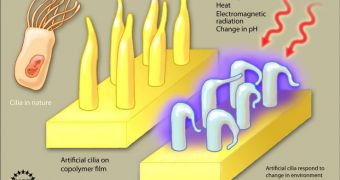In a new investigation, researchers based at the University of Southern Mississippi (USM) managed to develop a new material, that closely resembles the small structures known as cilia.
There are the formations that Mother Nature developed in order to give complex organisms the ability to hear, see, smell, and allow for fluid flow inside their bodies.
The newly-developed, skinny-molecule-based material manages to imitate the natural design to a great extent, the team behind the new work says. However, the scientists admit that the two are not identical.
Applications for the new material vary considerably, the researchers added, given that it responds to thermal, chemical, and electromagnetic stimulation. This means that scientists can control it externally.
“Our interest is in developing materials with multi-level responses at various length and time scales. I believe this is the future of science and engineering that will drive future technologies,” explains expert Marek Urban.
He is a professor of polymer science and engineering at the USM, and also the leader of the team that created the cilia-like material.
The scientist explains that the natural structures extend outwards from a variety of organs, and that they resemble human hairs. Their main role is to sense their surroundings, providing the brain with a steady flow of information.
For example, it's cilia in the inner ear that are moved by air flow, and that generate electrical potential when this happens. The electrical impulses are then sent to the brain, and we perceive them as hearing.
Details of the new investigation have been published in the esteemed scientific journal Advanced Functional Materials. The investigation took place at the USM Materials Research Science and Engineering Center for Response-Driven Polymeric Material.
The work was sponsored by the Division of Materials Research (DMR) at the US National Science Foundation (NSF).
According to Urban, the new development is of paramount importance. “Many new ideas are being generated as we speak, but it is too early to reveal them,” he goes on to say.
Biosensors are the first thing to come to mind, but one could envision a host of science-fiction applications for the distant future, such as for example creating airplanes that can hear.
Materials that are able to sense water may also be devised. They would be coated in artificial cilia, which will allow them to detect changes in temperature, humidity, noise levels, smells and so on.

 14 DAY TRIAL //
14 DAY TRIAL //